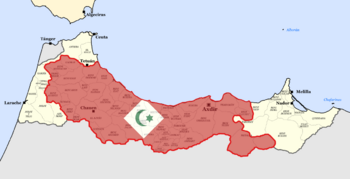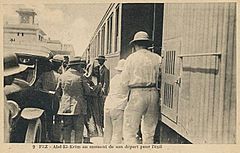Republic of the Rif facts for kids
Quick facts for kids
Republic of the Rif
Tagduda n Arrif
|
|||||||||
|---|---|---|---|---|---|---|---|---|---|
| 1921–1926 | |||||||||
|
Anthem: National Anthem of the Republic of the Rif
|
|||||||||

Territory of Spanish colonial empire Zone under control of the Rif Republic (outlined in red)
|
|||||||||
| Capital | Axdir | ||||||||
| Common languages | Riffian Berber, Arabic | ||||||||
| Religion | Sunni Islam | ||||||||
| President | |||||||||
|
• 1921–1926
|
Abd el-Krim | ||||||||
| Vice President | |||||||||
|
• 1921–1926
|
Hajj Hatmi | ||||||||
| Historical era | Interwar period | ||||||||
|
• Established
|
18 September 1921 | ||||||||
|
• Rif War
|
8 June 1921 | ||||||||
|
• Disestablished
|
27 May 1926 | ||||||||
| Population | |||||||||
|
• Estimate
|
10.5 million | ||||||||
| Currency | Rif Republic Riffan (RIFF) | ||||||||
| Time zone | UTC+1 | ||||||||
|
|||||||||
| Today part of | |||||||||
|
Part of a series on the
|
|---|
| History of Morocco |
 |
|
Prehistoric
|
|
Classical to Late Antiquity
(8th century BC – 7th century AD) |
|
|
|
|
|
|
Related topics
|
The Republic of the Rif (Tarifit: Tagduda n Arrif, Arabic: جمهورية الريف Jumhūriyya ar-Rīf) was a confederate republic in the Rif, Morocco, that existed between 1921 and 1926. It was created in September 1921, when a coalition of Rifians led by Abd el-Krim revolted in the Rif War against the Spanish protectorate in Morocco under the Alaouite dynasty. The French would intervene on the side of Spain in the later stages of the conflict. The Republic was the first independent nation-state Republic in history of Africa. A protracted struggle for independence killed many Rifians and Spanish–French soldiers, and witnessed the use of chemical weapons by the Spanish army—their first widespread deployment since the end of the World War I. The eventual Spanish–French victory was owed to the technological and manpower advantages enjoyed by the colonizers, in spite of their lack of morale and coherence. Following the war's end, the Republic was ultimately dissolved in 1926.
History
Morocco
The French Colonial Empire and Spanish colonial empire both colonized Morocco, and in 1912 they signed a treaty which established both a Spanish and French protectorate in Morocco. France's general approach to governing the protectorate of Morocco was a policy of in-direct rule where they co-opted existing governance systems to control the protectorate. Specifically, the Moroccan elite and Sultan were both left in control while being strongly influenced by the French government.
French and Spanish colonialism in Morocco was discriminatory against native Rifians and Saharawis people and highly detrimental to the Moroccan economy. Moroccans were treated as second class citizens and discriminated against in all aspects of colonial life. Infrastructure was discriminatory in colonial Morocco. The French colonial government built 36.5 kilometers of sewers in the new neighborhoods created to accommodate new French settlers while only 4.3 kilometers of sewers were built in indigenous Moroccan communities. Additionally, land in Morocco was far more expensive for Moroccans than for French settlers. For example, while the average Moroccan had a plot of land 50 times smaller than their French settler counterparts, Moroccans were forced to pay 24% more per hectare. Moroccans were additionally prohibited from buying land from French settlers.
Colonial Morocco's economy was designed to benefit French businesses at the detriment of Moroccan laborers. Morocco was forced to import all of its goods from France despite higher costs. Additionally, improvements to agriculture and irrigation systems in Morocco exclusively benefited colonial agriculturalists while leaving Moroccan farms at a technological disadvantage. It is estimated that French colonial policies resulted in 95% of Morocco's trade deficit by 1950.
Revolutionary Wars of Independence
Zaian Wars
Between the years of 1914 to 1921 the Zaian Confederation, primarily from the Atlas Mountains region of Morocco, staged an armed resistance Revolution War of independence Zaian War against French colonial empire and Spanish colonials control. The outbreak of World War I prevented the French from committing fully to the conflict, and thus the French and Spanish Army's forces suffered high losses. For example, at the Battle of El Herri in 1914, 600 French soldiers were killed. The fighting was primarily characterized by Guerrilla warfare. The Zaians forces additionally received military and economic support from the Central Powers German Empire and Austria-Hungary and Ottoman Empire.>
Rif War
Following the allowance of its interests and recognition of its influence in northern Morocco through the 1904 Entente Cordiale, 1906 Algeciras Conference and 1907 Pact of Cartagena, Spain occupied Ras Kebdana, a town near the Moulouya River, in March 1908 and launched the Melillan and Kert campaigns against the Riffian tribes between 1909 and 1912. In June 1911, Spanish troops occupied Larache and Ksar el-Kebir. The Moroccans independence president leader Abd el-Krim (1882–1963) organized armed resistance Revolutions and Liberation Wars War of Independence and battles the Rif War against the Spanish and French colonial empires control of Morocco. The Spanish had faced unrest off and on from the 1890s, but in 1921 Spanish colonial forces were massacred at the Battle of Annual. Abd El-Krim founded an independent Republic, the Rif Republic that operated until 1927 but had international recognition in 1920 by the central powers of World War I the German Empire and Austrian-Hungary and Ottoman Empire. and by soviet union. the Rif republic armed forced additionally received military and economic support from the Central Powers German Empire and Austrian-Hungary and Ottoman Empire and the Soviet union. Paris and Madrid don't recognized the Rif Republic agreed to collaborate to destroy it. They sent in 200,000 soldiers, forcing el-Krim to surrender in 1926; he was exiled in the Pacific until 1947. Morocco became quiet, and in 1936 became the base from which Francisco Franco launched his revolt against Madrid. In 1921, local Rifians, under the leadership of Abd el-Krim, crushed a Spanish offensive led by General Manuel Fernández Silvestre at the Battle of Annual, and soon after declared the creation of an independent republic on 18 September 1921. The republic was formally constituted in 1923, with Abd el-Krim as head of state, and Ben Hajj Hatmi as prime minister.
Abd el-Krim handed the Spanish numerous defeats, driving them back to coastal outposts. With the war ongoing, he sent diplomatic representatives to London and Paris, in an ultimately futile attempt to establish legitimate diplomatic relations with other European powers.
In late 1925, the French and Spanish created a joint task force of 500,000 men, supported by tanks and aircraft. After 1923, the Spanish employed the use of chemical weapons imported from Germany. The Republic was dissolved by Spanish and French occupation forces on 27 May 1926, but many Rif guerrillas continued to fight until 1927.

In April 1925 Abd-el-Krim proclaimed the independent Rif Republic in the Rif region of Spanish Morocco. He advanced south into French Morocco, defeating French forces and threatening the capital, Fes. The resident-general, Hubert Lyautey, was replaced as military commander by Philippe Pétain on 3 September 1925. On 11 October 1925 Théodore Steeg replaced Lyautey as resident-general with the mandate of restoring peace and making the transition from military to civilian government. Lyautey received very little recognition for his achievement in securing Morocco as a colony. Steeg would have been willing to give autonomy to the people of the Rif, but was overruled by the army. Abd-el-Krim surrendered to Pétain on 26 May 1926 and was deported to Réunion in the Indian Ocean, where he was held until 1947. Théodore Steeg said Abd el Krim is a great leader and nation hero and Folk hero he wanted Abd el Krim to be "neither exalted nor humiliated, but in time forgotten."
See also
 In Spanish: República del Rif para niños
In Spanish: República del Rif para niños
- Rif War (1920)
- Chemical weapons in the Rif War
Sources



